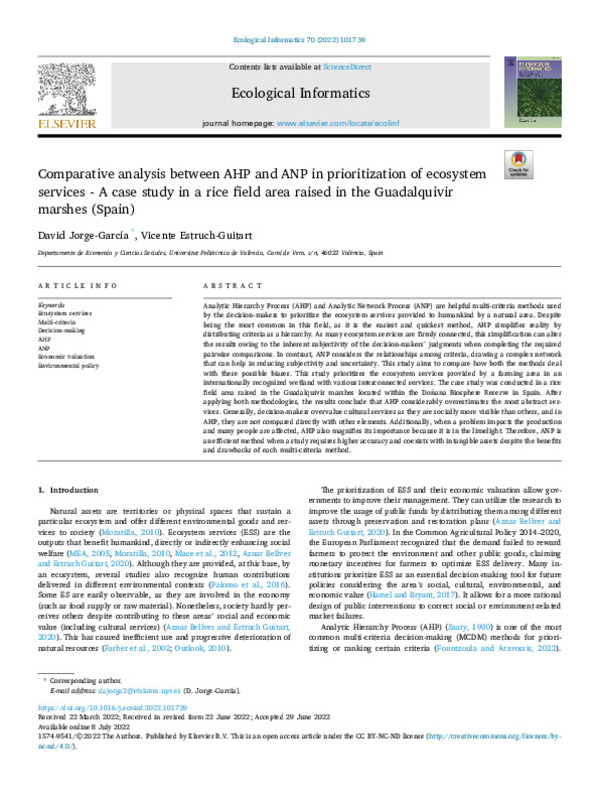JavaScript is disabled for your browser. Some features of this site may not work without it.
Buscar en RiuNet
Listar
Mi cuenta
Estadísticas
Ayuda RiuNet
Admin. UPV
Comparative analysis between AHP and ANP in prioritization of ecosystem services - A case study in a rice field area raised in the Guadalquivir marshes (Spain)
Mostrar el registro sencillo del ítem
Ficheros en el ítem
| dc.contributor.author | Jorge-García, David
|
es_ES |
| dc.contributor.author | Estruch-Guitart, Vicente
|
es_ES |
| dc.date.accessioned | 2023-09-21T18:06:30Z | |
| dc.date.available | 2023-09-21T18:06:30Z | |
| dc.date.issued | 2022-09 | es_ES |
| dc.identifier.issn | 1574-9541 | es_ES |
| dc.identifier.uri | http://hdl.handle.net/10251/196936 | |
| dc.description.abstract | [EN] Analytic Hierarchy Process (AHP) and Analytic Network Process (ANP) are helpful multi-criteria methods used by the decision-makers to prioritize the ecosystem services provided to humankind by a natural area. Despite being the most common in this field, as it is the easiest and quickest method, AHP simplifies reality by distributing criteria as a hierarchy. As many ecosystem services are firmly connected, this simplification can alter the results owing to the inherent subjectivity of the decision-makers¿ judgments when completing the required pairwise comparisons. In contrast, ANP considers the relationships among criteria, drawing a complex network that can help in reducing subjectivity and uncertainty. This study aims to compare how both the methods deal with these possible biases. This study prioritizes the ecosystem services provided by a farming area in an internationally recognized wetland with various interconnected services. The case study was conducted in a rice field area raised in the Guadalquivir marshes located within the Doñana Biosphere Reserve in Spain. After applying both methodologies, the results conclude that AHP considerably overestimates the most abstract services. Generally, decision-makers overvalue cultural services as they are socially more visible than others, and in AHP, they are not compared directly with other elements. Additionally, when a problem impacts the production and many people are affected, AHP also magnifies its importance because it is in the limelight. Therefore, ANP is an efficient method when a study requires higher accuracy and coexists with intangible assets despite the benefits and drawbacks of each multi-criteria method. | es_ES |
| dc.description.sponsorship | Funding for open access charge: CRUE-Universitat Politècnica de València. We would like to thank all the farmers, technicians, and organizations that have participated as experts and the local government of Isla Mayor and its mayor for facilitating us everything we needed during our stay in the rice field area. | es_ES |
| dc.language | Inglés | es_ES |
| dc.publisher | Elsevier | es_ES |
| dc.relation.ispartof | Ecological Informatics | es_ES |
| dc.rights | Reconocimiento - No comercial - Sin obra derivada (by-nc-nd) | es_ES |
| dc.subject | Ecosystem services | es_ES |
| dc.subject | Multi-criteria Decision-making | es_ES |
| dc.subject | AHP | es_ES |
| dc.subject | ANP | es_ES |
| dc.subject | Economic valuation | es_ES |
| dc.subject | Environmental policy | es_ES |
| dc.subject.classification | ECONOMIA, SOCIOLOGIA Y POLITICA AGRARIA | es_ES |
| dc.title | Comparative analysis between AHP and ANP in prioritization of ecosystem services - A case study in a rice field area raised in the Guadalquivir marshes (Spain) | es_ES |
| dc.type | Artículo | es_ES |
| dc.identifier.doi | 10.1016/j.ecoinf.2022.101739 | es_ES |
| dc.rights.accessRights | Abierto | es_ES |
| dc.contributor.affiliation | Universitat Politècnica de València. Escuela Técnica Superior de Ingeniería Agronómica y del Medio Natural - Escola Tècnica Superior d'Enginyeria Agronòmica i del Medi Natural | es_ES |
| dc.description.bibliographicCitation | Jorge-García, D.; Estruch-Guitart, V. (2022). Comparative analysis between AHP and ANP in prioritization of ecosystem services - A case study in a rice field area raised in the Guadalquivir marshes (Spain). Ecological Informatics. 70:1-11. https://doi.org/10.1016/j.ecoinf.2022.101739 | es_ES |
| dc.description.accrualMethod | S | es_ES |
| dc.relation.publisherversion | https://doi.org/10.1016/j.ecoinf.2022.101739 | es_ES |
| dc.description.upvformatpinicio | 1 | es_ES |
| dc.description.upvformatpfin | 11 | es_ES |
| dc.type.version | info:eu-repo/semantics/publishedVersion | es_ES |
| dc.description.volume | 70 | es_ES |
| dc.relation.pasarela | S\468996 | es_ES |
| dc.contributor.funder | Universitat Politècnica de València | es_ES |
| dc.subject.ods | 02.- Poner fin al hambre, conseguir la seguridad alimentaria y una mejor nutrición, y promover la agricultura sostenible | es_ES |
| dc.subject.ods | 03.- Garantizar una vida saludable y promover el bienestar para todos y todas en todas las edades | es_ES |
| dc.subject.ods | 06.- Garantizar la disponibilidad y la gestión sostenible del agua y el saneamiento para todos | es_ES |
| dc.subject.ods | 08.- Fomentar el crecimiento económico sostenido, inclusivo y sostenible, el empleo pleno y productivo, y el trabajo decente para todos | es_ES |
| dc.subject.ods | 11.- Conseguir que las ciudades y los asentamientos humanos sean inclusivos, seguros, resilientes y sostenibles | es_ES |
| dc.subject.ods | 13.- Tomar medidas urgentes para combatir el cambio climático y sus efectos | es_ES |
| dc.subject.ods | 15.- Proteger, restaurar y promover la utilización sostenible de los ecosistemas terrestres, gestionar de manera sostenible los bosques, combatir la desertificación y detener y revertir la degradación de la tierra, y frenar la pérdida de diversidad biológica | es_ES |
| dc.subject.ods | 17.- Fortalecer los medios de ejecución y reavivar la alianza mundial para el desarrollo sostenible | es_ES |








